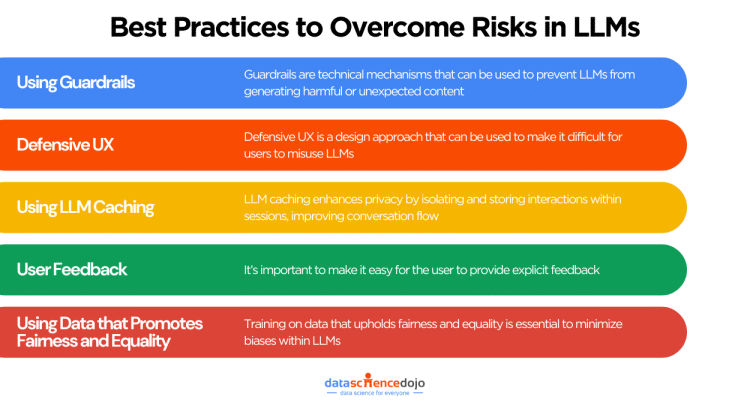Large language models hold the promise of transforming multiple industries, but they come with a set of potential risks. These risks of large language models include subjectivity, bias, prompt vulnerabilities, and more.
In this blog, we’ll explore these challenges and present best practices to mitigate them, covering the use of guardrails, defensive UX design, LLM caching, user feedback, and data selection for fair and equitable results. Join us as we navigate the landscape of responsible LLM deployment.
Key Challenges of Large Language Models
While LLMs are impressive in many ways, they come with significant challenges that can’t be ignored.
Here’s a complete to understanding large language models
Let’s break down some of the biggest concerns:
Subjectivity of Relevance for Human Beings
LLMs are trained on massive amounts of text and code, but that does not mean they always generate content that’s useful or relevant to everyone. Since different people have different perspectives, cultural backgrounds, and needs, LLMs lack true human understanding.
As a result, their responses may feel off, misaligned, or even completely irrelevant, especially when dealing with subjective topics like opinions, ethics, or personal preferences.
Bias Arising from Reinforcement Learning from Human Feedback (RHLF)
Many LLMs rely on Reinforcement Learning from Human Feedback (RLHF) to fine-tune their responses. The catch, however, is that human feedback is not perfect since it can be biased. This can lead to responses that favor certain viewpoints, reinforce stereotypes, or unintentionally discriminate against certain groups.
As a result, LLMs learn biased policies, reiterating those concepts rather than providing neutral, fair, or balanced perspectives.
Learn about RLHF and its role in AI applications
Prompt Leaking: When AI Spills the Beans
Imagine asking an LLM a simple question, and it accidentally reveals parts of its internal instructions or system prompts. This is called prompt leaking and poses a serious risk. It occurs when an LLM reveals its internal prompt or instructions to the user.
Attackers can exploit this weakness to extract information about how the model works or uncover sensitive data that should not be accessible. In security-sensitive applications, this could expose proprietary business logic or confidential user information.
Prompt Injection: The AI Hackers’ Trick
What if someone could trick an LLM into doing something it wasn’t designed to do? It is called prompt injection, where an attacker can inject malicious code into an LLM’s prompt.
It can cause an LLM to generate harmful or misleading content and bypass safety filters. It is one of the biggest challenges in ensuring that LLMs remain secure and trustworthy.
Jailbreaks: Bypassing AI’s Safety Barriers
A jailbreak is a successful attempt to trick an LLM into generating harmful or unexpected content. This can be done by providing the LLM with carefully crafted prompts or by exploiting vulnerabilities in the LLM’s code. A jailbreak occurs when someone finds a way to override an LLM’s built-in restrictions.
Skilled attackers can craft clever prompts that push the model past its safety limits. This can have serious consequences, such as spreading misinformation or generating dangerous advice.
Inference Costs
Inference cost is the cost of running a language model to generate text. It is driven by several factors, including the size, the complexity of the task, and the hardware used to run the model. LLMs are typically very large and complex models, which means that they require a lot of computational resources to run.
Hence, every time you generate text, the model requires powerful hardware, cloud resources, and electricity, adding up to high costs for businesses. These expenses can make large-scale AI adoption challenging, particularly for smaller companies that can’t afford the hefty price tag of running state-of-the-art LLMs.
Curious about LLMs, their risks, and how they are reshaping the future? Tune in to our Future of Data and AI podcast now!
Quick Quiz
Test your knowledge of large language models
Hallucinations
LLMs hallucinate when they generate false information while sounding factual. There are several factors that can contribute to hallucinations in LLMs, including the limited contextual understanding of LLMs, noise in the training data, and the complexity of the task.
When pushed too far, LLMs may fabricate facts, citations, or research, leading to misinformation in critical fields. Other potential risks of LLMs include privacy violations and copyright infringement. These are serious problems that companies need to be aware of before implementing LLMs.
Listen to this talk to understand how these challenges plague users as well as pose a significant threat to society.
Thankfully, there are several measures that can be taken to overcome these challenges.
Best Practices to Mitigate These Challenges
Here are some best practices that can be followed to overcome the potential risks of LLMs.

1. Using Guardrails
Guardrails are technical mechanisms that can be used to prevent large language models from generating harmful or unexpected content. For example, guardrails can be used to prevent LLMs from generating content that is biased, offensive, or inaccurate.
Guardrails can be implemented in a variety of ways. For example, one common approach is to use blacklists and whitelists. Blacklists are lists of words and phrases that a language model is prohibited from generating. Whitelists are lists of words and phrases that the large language model is encouraged to generate.
Another approach to guardrails is to use filters. Filters can be used to detect and remove harmful content from the model’s output. For example, a filter could be used to detect and remove hate speech from the LLM’s output.
2. Defensive UX
Defensive UX is a design approach that can be used to make it difficult for users to misuse LLMs. For example, defensive UX can be used to make it clear to users that LLMs are still under development and that their output should not be taken as definitive.
One way to implement defensive UX is to use warnings and disclaimers. For example, a warning could be displayed to users before they interact with it, informing them of the limitations of large language models and the potential for bias and error.
Another way to implement defensive UX is to provide users with feedback mechanisms. For example, a feedback mechanism could allow users to report harmful or biased content to the developers of the LLM.
3. Using LLM Caching
LLM caching reduces the risk of prompt leakage by isolating user sessions and temporarily storing interactions within a session, enabling the model to maintain context and improve conversation flow without revealing specific user details.
This improves efficiency, limits exposure to cached data, and reduces unintended prompt leakage. However, it’s crucial to exercise caution to protect sensitive information and ensure data privacy when using large language models.
4. User Feedback
User feedback can be used to identify and mitigate bias in LLMs. It can also be used to improve the relevance of LLM-generated content. One way to collect user feedback is to survey users after they have interacted with an LLM. The survey could ask users to rate the quality of the LLM’s output and identify any biases or errors.
Another way to collect user feedback is to allow users to provide feedback directly to the developers of the LLM. This feedback could be provided via a feedback form or a support ticket.
5. Using Data that Promotes Fairness and Equality
It is of paramount importance for machine learning models, particularly Large Language Models, to be trained on data that is both credible and advocates fairness and equality. Credible data ensures the accuracy and reliability of model-generated information, safeguarding against the spread of false or misleading content.
To do so, training on data that upholds fairness and equality is essential to minimize biases within LLMs, preventing the generation of discriminatory or harmful outputs, promoting ethical responsibility, and adhering to legal and regulatory requirements.
Overcome the Risks of Large Language Models
In conclusion, LLMs offer immense potential but come with inherent risks, including subjectivity, bias, prompt vulnerabilities, and more. This blog has explored these challenges and provided a set of best practices to mitigate them.
These practices encompass implementing guardrails to prevent harmful content, utilizing defensive user experience (UX) design to educate users and provide feedback mechanisms, employing LLM caching to enhance user privacy, collecting user feedback to identify and rectify bias, and, most crucially, training LLMs on data that champions fairness and equality.
By following these best practices, we can navigate the landscape of responsible LLM deployment, promote ethical AI development, and reduce the societal impact of biased or unfair AI systems.





